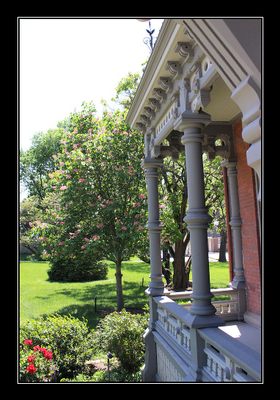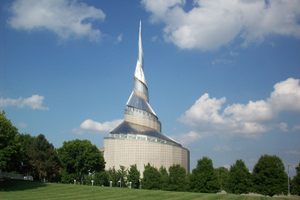About
The stunning mansion is an example of the opulent architectural style of the Second Empire. As with some of the other elaborate homes in Independence, it's now a house museum that is open for tours. The Harvey M. Vaile Mansion, was built in 1881 for a wealthy businessman, Colonel Harvey Vaile and his wife Sophia. Vaile, born in Vermont in 1831, graduated with a law degree from the University of Louisville, and, like so many adventurers of the day, headed west to seek his fortune. Vaile arrived in Kansas City in 1859.
Construction on this estate began in 1871 and took a decade to complete. The property originally encompassed some 630 acres, which included a vineyard and an apple orchard (there was a wine processing plant on the property as well as an ample wine cellar). Today, the site sits on a 5.6-acre lot. Its total construction cost was approximately $150,000—equivalent to about $3-4 million today. It was designed by Kansas City architect Asa Beebe Cross, inspired by a building in Normandy, France.
It's a two-and-a-half story block with a three-story central tower constructed primarily of red brick. There are also limestone mouldings, bracketed cornices, and slate shingles adorning its most famous feature, the mansard roofs. It contains 31 rooms with 14-foot ceilings. The original furnishings were auctioned off after the house was sold, but the interiors still feature original paintwork, marble fireplaces and two of the three chandeliers. (The chandeliers were originally produced for the White House, but Vaile was able to purchase them because they were slightly flawed.)
The house also featured some state-of-the-art amenities, including speaking tubes (a kind of rudimentary intercom system popular in 19th century homes), indoor hot and cold water, and flush toilets—it was reportedly the first home in Jackson County to feature indoor plumbing. The estate was described by a Kansas City Times reporter in 1882 as "the most princely house... in the entire west."
However, life at the mansion was not always grand. Vaile was eventually charged with defrauding the government over an investment scandal.He faced two trials, and though he was found not guilty, had spent more than $100,000 in legal expenses. Unfortunately, his troubles continued, as his wife fell ill, and then was found dead at the home in 1883. Vaile continued to live in his mansion until his death in 1895. Ownership of his estate was highly contested, and a legal battle ensued.
The house was eventually sold, and became a sanatorium in 1908, then was converted into a nursing home, then a business, a spring water bottling company. The mansion had become dilapidated over the decades, but it was finally purchased by Roger and Mary Mildred DeWitt, who undertook extensive repairs and renovation. In 1983, the DeWitts donated the house to the city, and it underwent an even more significant renovation project. It's now a house museum operated by the Vaile Victorian Society, a non-profit organization established in 1983.
Related Tags
Know Before You Go
Regular Tour Season: April 1st - October 31st, Thursday-Saturday 10 a.m. - 4 p.m. and Sunday 1 p.m. - 4 p.m.
Holiday Tour Hours: November 25th-December 30th, Closed Dec. 23rd-25th, Thursday-Saturday 10 a.m. - 4 p.m. and Sunday 1 p.m. - 4 p.m.
Purchase tickets at the door (cash or credit cards): Adults $10.00, Groups of 15 or more - $8.00, Children ages 6-12 $5.00
Community Contributors
Added By
Published
January 27, 2020































